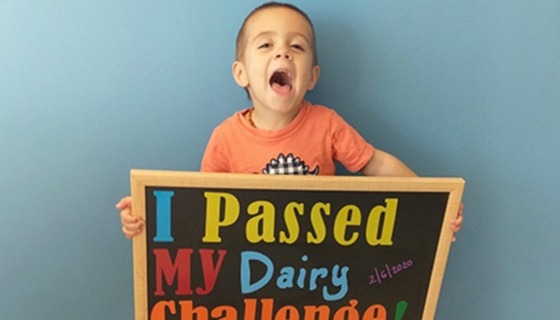Food Allergies in Children and Babies
A food allergy happens when the immune system reacts to a certain food protein. Although symptoms can be the same, food allergies are different than a food intolerance. Food intolerance does not affect the immune system. Some children can have potentially life-threatening reactions to food allergies, so it is important to have a food allergy confirmed by an allergist and follow directions for allergy management.
Immunoglobulin E (IgE)-mediated Food Allergies
The most common food allergies are considered IgE-mediated, which are caused by immunoglobulin E antibodies’ reaction with food. This reaction leads to histamine or other allergic substances being released.
IgE-mediated food allergies can be serious or potentially life-threatening.
What are common IgE-mediated food allergens in children and babies?
In the United States, the nine major food allergens are:
- Milk
- Eggs
- Wheat
- Soybeans
- Tree nuts
- Peanuts
- Fish
- Shellfish
- Sesame
Approximately 90% of all food allergies are caused by these nine allergens. Eggs, milk and peanuts are the most common causes of food allergies in children. Peanuts, tree nuts, fish and shellfish commonly cause the most severe reactions.
Nearly 8% of children under the age of 5 years have food allergies. Allergies to milk, egg, wheat and soy often resolve in childhood, but can persist for longer or can be lifelong for some. Allergies to peanuts, tree nuts, fish and/or shellfish are typically lifelong.
Food allergy symptoms in children and babies
Food allergy symptoms may begin within minutes to an hour after eating the food. However, each child may experience symptoms differently.
Symptoms may include:
- Nausea or vomiting
- Diarrhea
- Stomach cramps or pain
- Rash or hives
- Face swelling
- Eczema
- Itching or swelling of the lips, tongue or mouth
- Itching or tightness in the throat
- Difficulty breathing or wheezing
- Lowered blood pressure combined with dizziness
Anaphylaxis, a sudden, life-threatening reaction of shock to the whole body, is a severe, life-threatening reaction. It does not take much of the food to cause a severe reaction in highly allergic children.
Symptoms of food allergy may resemble other problems or medical conditions. Always consult your child's doctor for a diagnosis.
Groundbreaking Findings on Food Allergy Treatment

An NIH-funded multi-phase study that initially led to FDA approval of the injectable drug, omalizumab, for food allergy treatment, has now found that the drug performs better than oral immunotherapy - the only additional FDA-approved treatment for food allergy.
A subsequent phase of the study also found that patients may be able to introduce allergenic foods into their diets after stopping the medicine.
Without research—at Johns Hopkins and at other institutions—scientific breakthroughs suffer, and the lifesaving treatments of tomorrow are at risk.
Food-allergy management and treatment for children and babies
The best management of food allergy in children is avoidance and being prepared to treat a reaction.
Children who are at risk of anaphylaxis should carry two epinephrine autoinjectors at all times. This medicine helps stop the symptoms of severe reactions. Talk to the child's doctor to learn how to use it. Make sure those close to your child — such as teachers, care providers and family members — also know how to use it.
Some children may outgrow their allergies and may be able to eat the food as they get older. Reintroduce a food only after discussing it with the child's physician, who can discuss follow-up testing or food challenges to ensure reactions do not occur.
Food Allergen Labeling
The Food Allergen Labeling and Consumer Protection Act of 2024 requires that foods containing milk, egg, wheat, soy, peanut, tree nuts, crustaceans and fish be listed in plain English on the label.
Labeling requirements can vary by country. It is important to check the local labeling laws before travelling outside of the United States.
Dining out with a child with food allergies
Keep the following in mind while dining out with a child with food allergies:
- Know what ingredients are in the foods at the restaurant. When possible, get a menu from the restaurant ahead of time and review the menu items.
- Let the server know about your child’s food allergy from the start. Ask how a dish is prepared and the ingredients before ordering. If the server doesn't know this information or seems unsure of it, ask to speak to the manager or the chef.
- Do not use buffet or family-style service. There may be cross-contamination of foods from using the same serving utensils for different dishes.
- Be cautious of fried foods. The same oil may be used to fry several different foods.
A food allergy card, which can be given to a restaurant server or manager before ordering food for your child, contains information about the specific foods to which your child is allergic. It also has information such as reminders to make sure utensils and equipment used to prepare the meal are thoroughly cleaned before use.
If a child is eating out with friends or other family members, be sure they or an adult in charge has the child’s food allergy card to give to the server.
Eating at school with food allergies
Educate appropriate people at your child's school about the child’s allergy. Share an anaphylaxis action plan from their doctor, and make sure there are two epinephrine autoinjectors and designated administrators.
In addition, your school will likely have specific forms about your child’s medications and allergies that should be completed by your physician. Update information at the start of each school year and as treatment changes or new information becomes available.
Treatments for food allergies in children
There is currently no cure for food allergy in children, however there are two FDA-approved food allergy medications. Talk to your child's doctor to see if these medications are an option for your child.
Omalizumab helps reduce allergic reaction if your child is accidentally exposed to several different types of food allergies. Omalizumab is a monoclonal antibody given as an injection. It is approved for children over the age of one. Children who take this medicine should still avoid the foods to which they are allergic.
Palforzia peanut oral immunotherapy reduces the risk of allergic reactions in children with a confirmed peanut allergy. It is for children and teens ages 4 to 17. Even if a child is taking this medicine, they should not eat peanuts or peanut products.
There are currently several other food allergy treatments in clinical trials.
Food allergy prevention for children and babies
For many years, it was advised to delay giving children certain highly allergenic foods until after the age of 1. However, new research shows that early introduction of peanut and egg may prevent a food allergy.
For that reason, current guidelines by the major allergy societies recommend introducing peanut and egg-containing products to all infants starting around 6 months old. They also state that families should not delay introduction of other allergenic foods.
Non-IgE-mediated food allergies
The less common type of food allergy is considered non-IgE-mediated. These are caused by a reaction involving parts of the immune system separate from IgE antibodies.
Non-IgE-mediated allergies usually occur with stomach-related symptoms, such as vomiting, diarrhea, or blood in the stool, or skin redness, dryness or itching. Symptoms typically show hours or weeks after food ingestion.






